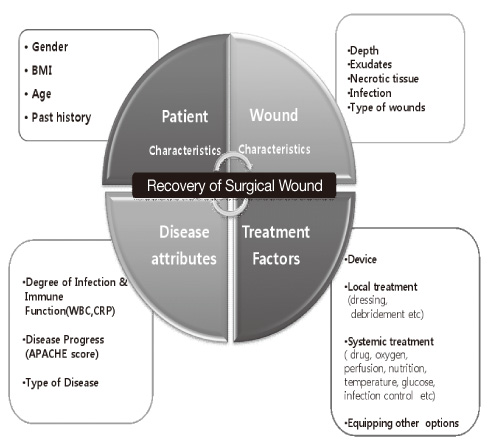J Korean Acad Nurs.
2011 Dec;41(6):768-779. 10.4040/jkan.2011.41.6.768.
Adaptation of Evidence-based Surgical Wound Care Algorithm
- Affiliations
-
- 1Department of Biobehavioral Nursing Science, Seoul National University, Seoul, Korea.
- 2College of Nursing, Research Institute of Nursing Science, Seoul National University, Seoul, Korea. smi@snu.ac.kr
- KMID: 1120109
- DOI: http://doi.org/10.4040/jkan.2011.41.6.768
Abstract
- PURPOSE
This study was designed to adapt a surgical wound care algorithm that is used to provide evidence-based surgical wound care in a critical care unit.
METHODS
This study used, the 'ADAPTE process', an international clinical practice guideline development method. The -'Bonnie Sue wound care algorithm' - was used as a draft for the new algorithm. A content validity index (CVI) targeting 135 critical care nurses was conducted. A 5-point Likert scale was applied to the CVI test using a statistical criterion of .75.
RESULTS
A surgical wound care algorithm comprised 9 components: wound assessment, infection control, necrotic tissue management, wound classification by exudates and depths, dressing selection, consideration of systemic factors, wound expected outcome, reevaluate non-healing wounds, and special treatment for non-healing wounds. All of the CVI tests were > or =.75. Compared to existing wound care guidelines, the new wound care algorithm provides precise wound assessment, reliabilities of wound care, expands applicability of wound care to critically ill patients, and provides evidence and strength of recommendations.
CONCLUSION
The new surgical wound care algorithm will contribute to the advancement of evidence-based nursing care, and its use is expected as a nursing intervention in critical care.
MeSH Terms
Figure
Reference
-
1. Manual for guideline adaptation, version 1.0. ADAPTE collaboration. 2007. March 10, 2010. from http://www.adapte.org/www/upload/actualite/pdf/Manual%20&%20Toolkit.pdf.2. Appraisal of Guidelines Research and Evaluation [AGREE] collaboration. Development and validation of an international appraisal instrument for assessing the quality of clinical practice guidelines: The AGREE project. Quality & Safety in Health Care. 2003. 12(1):18–23. doi: 10.1136/qhc.12.1.18.3. Bolton L, McNees P, van Rijswijk L, de Leon J, Lyder C, Kobza L, et al. Wound-healing outcomes using standardized assessment and care in clinical practice. Journal of Wound, Ostomy, and Continence Nursing. 2004. 31:65–71.4. Bowler PG. The 10(5) bacterial growth guideline: Reassessing its clinical relevance in wound healing. Ostomy/Wound Management. 2003. 49:44–53.5. Collier M. The principles of optimum wound management. Nursing Standard. 1996. 10(43):47–52.6. ConvaTec. SOLUTIONS wound care algorithm. 2008. Princeton (NJ): ConvaTec, a Bristol-Myers Squibb Company and National Institutes of Health.7. Courtney M. Evidence for nursing practice. 2005. Marrickvile: Churchill Livingstone.8. GRADE Working Group. Grading quality of evidence and strength of recommendations. BMJ. 2004. 328:1490. doi: 10.1136/bmj.328.7454.1490.9. Graham ID, Harrison MB. Evaluation and adaptation of clinical practice guidelines. Evidence-Based Nursing. 2005. 8:68–72. doi: 10.1136/ebn.8.3.68.10. Harris C, Bates-Jensen B, Parslow N, Raizman R, Singh M, Ketchen R. Bates-Jensen wound assessment tool: Pictorial guide validation project. Journal of Wound, Ostomy, and Continence Nursing. 2010. 37:253–259. doi: 10.1097/WON.0b013e3181d73aab.11. Janis JE, Kwon RK, Lalonde DH. A practical guide to wound healing. Plastic and Reconstructive Surgery. 2010. 125(6):230e–244e. doi: 10.1097/PRS.0b013e3181d9a0d1.12. Kim ES. Development and application of blood glucose control protocol in medical ICU patients. 2009. Seoul: Seoul National University;Unpublished doctoral dissertation.13. Lee EO, Im NY, Park HA, Lee IS. Statistical analysis for nursing and medical research. 2009. Seoul: Soomunsa.14. Melnyk BM, Fineout-Overholt E. Evidence-based practice in nursing & healthcare: A guide to best practice. 2005. Philadelphia: Lippincott Williams & Wilkins.15. Mirza SK, Deyo RA, Heagerty PJ, Turner JA, Lee LA, Goodkin R. Towards standardized measurement of adverse events in spine surgery: Conceptual model and pilot evaluation. BMC Musculoskeletal Disorders. 2006. 7:53. doi: 10.1186/1471-2474-7-53.16. Myers BA. Wound management: Principles and practice. 2007. 2nd ed. New Jersey: Prentice Hall.17. Patel KL. Impact of tight glucose control on postoperative infection rates and wound healing in cardiac surgery patients. Journal of Wound, Ostomy, and Continence Nursing. 2008. 35(4):397–404. doi: 10.1097/01.WON.0000326659.47637.d0.18. Petzina R, Hoffmann J, Navasardyan A, Malmsjo M, Stamm C, Unbehaun A, et al. Negative pressure wound therapy for post-sternotomy mediastinitis reduces mortality rate and sternal re-infection rate compared to conventional treatment. European Journal of Cardiothoracic Surgery. 2010. 38:110–113. doi: 10.1016/j.ejcts.2010.01.028.19. Pillen H, Miller M, Thomas J, Puckridge P, Sandison S, Spark JI. Assessment of wound healing: Validity, reliability and sensitivity of available instruments. Wound Practice and Research. 2010. 17(4):208–217.20. Polit DF, Beck CT. The content validity index: Are you sure you know what's being reported? Critique and recommendations. Research in Nursing and Health. 2006. 29:489–497. doi: 10.1002/nur.20147.21. Ruth AB, Denised PN. Acute and chronic wounds: Nursing management. 2007. 3rd ed. St. Louis: Mosby.22. Sheer B, Wong FK. The development of advanced nursing practice globally. Journal of Nursing Scholarship. 2008. 40:204–211. doi: 10.1111/j.1547-5069.2008.00242.x.23. Stevens J. Multivariate statistics for the social sciences. 1996. 3rd ed. NJ: Lawrence Erlbaum.24. Sussman C. Bates Jensen BM, Sussman C, editors. Tools to measure wound healing. Wound care. 2007. Baltimore: Lippincott, Williams & Wilkins;123–169.25. William JE, Emily F, Katie M, Patricio M. Wound healing outcomes: The impact of site of care and patient stratification. Wounds. 2007. 19:286–293.26. Wilson MC, Hayward RS, Tunis SR, Bass EB, Guyatt G. The evidence-based medicine working group. Users' guides to the medical literature. VIII. How to use clinical practice guidelines. B. what are the recommendations and will they help you in caring for your patients? Journal of the American Medical Association. 1995. 274:1630–1632.
- Full Text Links
- Actions
-
Cited
- CITED
-
- Close
- Share
- Similar articles
-
- Development of an Algorithm for the Prevention and Management of Pressure Ulcers
- Evidence-based Clinical Practice Protocol of Physical Restraints by Adaptation Process for Patients in a Geriatric Hospital
- Adaptation of the Evidence-Based Nursing Practice Guideline: Prevention and Management of Moisture Associated Skin Damage
- vidence-Based Nursing Practice Guideline: Ostomy Care
- The Significance of Home Care Wound Management after Dermatologic Surgery



